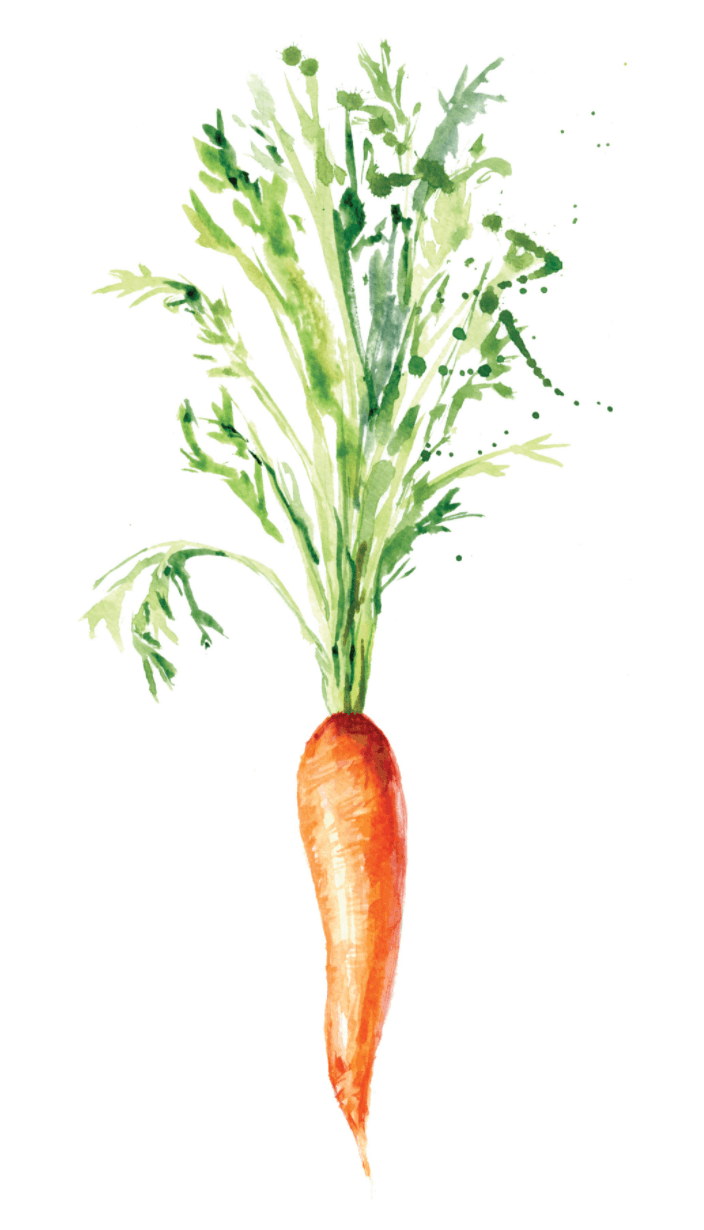
Creative freedom is a huge carrot.” Film and television director and producer AdamMcKay may have been explaining, when he said those words, why independent filmmaking was a draw for him, but I read the sentence through a culinary lens.
Creative freedom is, indeed, a huge carrot.
It’s true. The ubiquitous carrot, which is seemingly always in season in one variety or another, can be prepared with imagination in myriad ways. And in doing so, the carrots in your refrigerator at home can take you anywhere you might want to go. Raw, with most of the dirt brushed off, and you’re a kid in the backyard garden. Peeled, steamed, and tossed with spicy harissa and preserved lemon, and you’re in a restaurant in Morocco. Shredded into a cake, and you’re sitting at your grandmother’s kitchen table. Sliced and simmered in chicken broth with onions and thyme, and you’re with Alice Waters at Chez Panisse in Berkeley.
Carrots have a long history. They originated in ancient Persia. Seeds have been found in Switzerland and Germany dating back to 3000 B.C., when their leafy greens were used medicinally. References to eating carrot roots like we do now appeared in 1st century A.D. Roman texts. The Moors brought them to Spain circa 900, and the Dutch are widely credited with engineering an orange version of the previously purple root around 1600.
Carrot eating has been on the rise for eons, but scientists say the nutritional value of the vegetable has declined overtime. In a landmark study published in 2005, University of Texas researchers professor analyzed USDA carrot nutrient data collected between 1950 to 2000 and saw a decline in the amount of protein, calcium, phosphorus, iron, riboflavin (vitamin B2), and vitamin C in modern carrots bred over time for size, growth rates, yield, and pest resistance, but not nutritional density.
Regenerative agriculture practices—like low and no tilling of the soil, using rotational cover crops to let fields rest every few years, and integrating grazing animals into the mix—are being used more and more on smaller farms around the world. The result is nutrient dense soil that can pull carbon out of the air to help fight climate change, hold onto water better, and grow more nutrient dense vegetables, like carrots. This may just be the season to buy your carrots from a local small farmer who uses these practices; they may be better for both your body and the earth.

Grilled Carrots with Za'atar, Labneh, and Olive Oil
Ingredients
- 2 pounds medium multi-colored carrots peeled and ends trimmed
- Olive oil
- Kosher salt
- Black pepper
- 1 cup labneh
- 1 tablespoon lemon zest
- 1-2 tablespoons za’atar
- Flaky sea salt
- Chopped carrot tops optional
Instructions
- ►Preheat a grill to medium-high. If using a gas grill, turn off all but one section of flame under the grates. For a charcoal grill, bank the coals to one side of the kettle.
- ►Toss carrots with 1 tablespoon olive oil, ½ teaspoon salt and ¼ teaspoon pepper. Place on the grill, positioned directly over the heat. Grill carrots, turning often until they are charred in spots, 7-10 minutes. Transfer to grate away from direct heat, cover grill, and cook until tender, 15-20 minutes. Remove from grill and cool to room temperature.
- ►Smear labneh over the surface of a serving platter. Drizzle with olive oil and sprinkle with lemon zest. Arrange grilled carrots on top. Sprinkle with za’atar, flaky sea salt, and carrot tops, if using.




